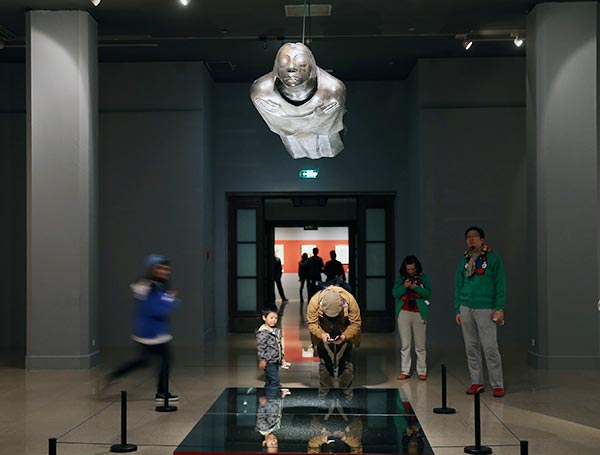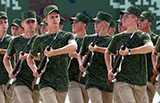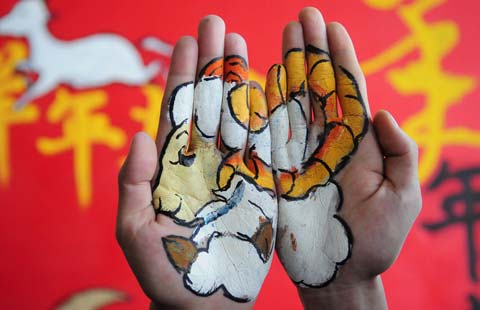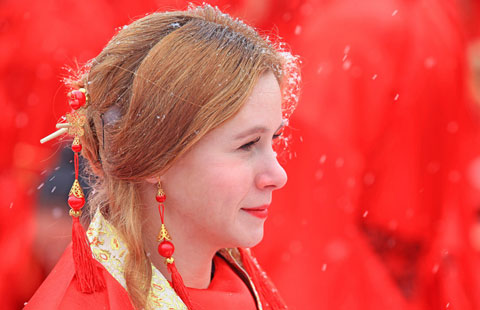Printmaker's art captures tragedy of war victims
Updated: 2015-10-27 08:41
By Lin Qi(China Daily)
|
||||||||
 |
|
Power of Black and White shows the impact of Kaethe Kollwitz's art in Germany and China. [Photo by Jiang Dong/China Daily] |
Another sculpture, Der Schwebende (the floating), portrays a flying angel hung in midair. The angel's face resembles Kollwitz's and the piece is the only exhibit not her work.
It was crafted by Ernst Barlach, the German expressionist sculptor and a longtime friend who shared common artistic views, and who imported in the sculpture his respect of Kollwitz.
"Her heart and mind were always occupied with empathy for the poor," Klaus Siebenhaar, a professor with Free University of Berlin, says of Kollwitz. He curated the exhibition with his colleague Matthias Henkel.
"She and her husband, Karl Kollwitz, a doctor, lived in a district where a lot of the underprivileged took shelter. Karl treated poor patients at their apartment, by which Kathe got to be more knowledgeable of their situations and was inspired to create," Siebenhaar tells China Daily.
Siebenhaar says the exhibition shows the impact of Kollwitz's art in Germany and how it influenced Chinese art.
Dozens of schools in Germany are named after her and three museums are solely dedicated to her art, including the Kaethe Kollwitz Museum Berlin, whose collections are on show.
Kollwitz has a lot of Chinese fans who are fascinated by both the miseries and beauty of life expressed in her works.
Her art and engraving style has influenced profoundly several generations of Chinese printmaking artists since the 1930s, Wu says.
Despite her achievements, Kollwitz never regarded herself as someone special, according to Jan Kollwitz, her great-grandson and a ceramic artist.
"She lived a very modest and ordinary life. Because Karl (the husband) served the poor, they couldn't afford to buy a house and settled in apartments," Jan Kollwitz says.
There are four sculptures on show that are from the family collection.
"She was struggling with expressing purity in her works. She worked hard till the last moment of her life," he says.
If you go
9 am-5 pm, through Nov 23. National Art Museum of China, 1 Wusi Street, Dongcheng district, Beijing. 010-6400-1476.
Related:
Art fete showcases close bonds with Mongolia
Auction to put focus on growth of Chinese oil painting

 Sister cities mingle in Chicago
Sister cities mingle in Chicago
 Girl with a sand painting dream
Girl with a sand painting dream
 Decorating benefactors make a dorm a cozy home
Decorating benefactors make a dorm a cozy home
 The world in photos: Oct 19 - 25
The world in photos: Oct 19 - 25
 Hamilton takes third F1 title after US thriller
Hamilton takes third F1 title after US thriller
 Qipaos sizzle on the runway as China Fashion Week kicks off
Qipaos sizzle on the runway as China Fashion Week kicks off
 President Xi visits Man City football club
President Xi visits Man City football club
 British PM Cameron treats President Xi to beer, fish and chips in English pub
British PM Cameron treats President Xi to beer, fish and chips in English pub
Most Viewed
Editor's Picks

|

|

|

|

|

|
Today's Top News
Tu first Chinese to win Nobel Prize in Medicine
Huntsman says Sino-US relationship needs common goals
Xi pledges $2 billion to help developing countries
Young people from US look forward to Xi's state visit: Survey
US to accept more refugees than planned
Li calls on State-owned firms to tap more global markets
Apple's iOS App Store suffers first major attack
Japan enacts new security laws to overturn postwar pacifism
US Weekly

|

|








